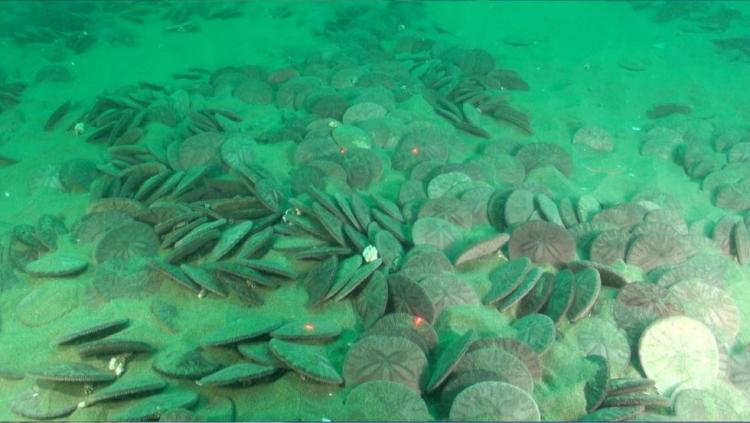Soft bottom subtidal habitat includes all of the unconsolidated substrate areas (e.g., mud, sand, granule pebbles and various mixes thereof) on the ocean bottom. Soft bottom subtidal habitats are characterized by CMECS as being within the subtidal zones of the nearshore and offshore marine subsystems. Subtidal soft bottom habitats are diverse based on distinct organism assemblages that are influenced by differences in substrate type (sand vs. mud), organic content and bottom depth. The distribution and relative abundance and mixes of these substrates are not yet well described for much of Oregon’s nearshore ocean waters.
Physical Environment
The primary substrate types in Oregon’s soft bottom subtidal areas range from sand to pebble. CMECS defines unconsolidated mineral substrates based on particle diameter. Here we consider soft bottom habitats to be composed of the various mixes defined by CMECS of particles <64 mm in diameter. Because the Oregon coast is primarily an exposed, high energy environment, most soft bottom subtidal areas are sandy. However, mud can be the more prevalent substrate type in areas receiving less energy from water movement, including isolated and sheltered areas, and deeper areas. The distribution of these unconsolidated sediment types in Oregon waters is influenced by currents in both the nearshore and offshore subsystems. Areas close to outfalls and discharge pipes would be expected to show localized differences based on the displacement of substrate and the increased availability of organic and small particulate material. The smaller the particle size, the smaller the pores (or spaces between the particles) are. Pore size dictates the amount of water and the water chemistry of the substrate, which can define what types of organisms can live in that sediment.
Biological Characteristics
Most soft bottom subtidal communities are dominated by infaunal (burrowing) invertebrates such as polychaete worms. However, other organisms such as crustaceans, echinoderms and mollusks may be locally abundant. Common epifauna (found on the sediment surface) can include species of shrimp, crabs, snails, bivalves, sea cucumbers, and sand dollars. Dungeness crab are an important component of soft bottom subtidal communities and are found both on the surface as well as buried in the substrate. Sea pens (Ptilosarcus sp.), colonial relations to sea anemones, are common on more muddy bottoms. Common fish in this area include several species of flatfish (e.g., sanddab, English sole, and sand sole), and important burrowing forage species such as Pacific sand lance and sandfish.
Species associated with soft bottom subtidal habitats provide a spectrum of ecosystem services. Most widespread but least apparent of these services are the nutrient cyclers: deposit feeders and microbes living within the sediments. Emergent species such as sea pens in more quiet areas are only found in this habitat. There are a vast array of worms and other invertebrates that live in the soft subtidal bottom. Soft bottom habitats are important to many Strategy, Watch List and other commonly associated species at various life stages (Table 6.3, Appendix E and F). For example, big skate, starry flounder, sand sole, Pacific sand lance burrow or cover themselves to hide in these sediments. Gray whales feed by sifting buried amphipods from the sediments. Many invertebrates like razor and native littleneck clams live in the subtidal soft bottom habitat. Both juvenile and adult Dungeness crab forage here and sometimes hide in these soft sediments. The young of commercially valuable fish species can often be found here and utilize these areas as nursery habitat. The young of many species use the nearshore area for foraging, and are themselves prey for larger fishes and birds. Sand lance is a particularly valuable forage species for birds, other fishes, and marine mammals. Diving birds such as the common murre forage for food for their young in soft bottom areas taking juvenile flat fish back to their chicks while they are nesting.
Human Use
Commercial and recreational harvest of Dungeness crab, surf perch, and species of nearshore flatfish are the principal human uses of the soft bottom subtidal habitat. Sand and mud from dredging projects are sometimes deposited over soft bottom habitats. Soft bottom subtidal habitats could also soon be utilized for siting renewable energy projects and their associated infrastructure. Finally, the soft bottom subtidal offers many opportunities for scientific research.
